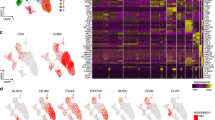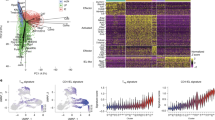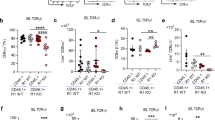Abstract
Intraepithelial lymphocytes (IEL) of the small murine bowel represent a unique population of mostly CD8+ T lymphocytes that reside within the epithelial cell layer of the intestinal mucosa. The close interaction with epithelial cells appears to be crucial for IEL survival since isolation and ex vivo culture induces massive apoptosis in this lymphocyte population. Here, we provide evidence that this form of IEL cell death may be mediated at least in part by endogenously produced glucocorticoids since adrenalectomy or treatment of mice with a glucocorticoid receptor antagonist significantly enhanced ex vivo survival of IEL. We further demonstrate that ex vivo activation of IEL induces upregulation of anti-apoptotic gene products, compensates for the lack of survival cytokines and rescues from apoptotic cell death. Thus, similar to thymocytes and T cell hybridomas, IEL survival may be regulated by the antagonistic action of TCR activation and glucocorticoids.
Similar content being viewed by others
Log in or create a free account to read this content
Gain free access to this article, as well as selected content from this journal and more on nature.com
or
Abbreviations
- AICD:
-
activation-induced cell death
- CD95:
-
Fas/APO-1
- CD95L:
-
CD95 ligand
- sCD95-Fc:
-
soluble CD95-human IgG1 fusion protein
- cIAP:
-
cellular inhibitor of apoptosis
- dex:
-
dexamethasone
- HBS:
-
HEPES-buffered saline
- IL:
-
interleukin
- IEL:
-
intraepithelial lymphocytes
- PMA:
-
phorbolmyristate acetate
- RT–PCR:
-
reverse transcription polymerase chain reaction
- RU-486:
-
mifepristone
- TGFβ:
-
transforming growth factor β
- TCR:
-
T cell receptor
- TNFα:
-
tumor necrosis factor α
- TUNEL:
-
TdT-mediated dUTP nick end labeling
References
Rocha B, Guy-Grand D, Vassalli P . 1995 Extrathymic T cell differentiation Curr. Opin. Immunol. 7: 235–242
Lefrancois L, Puddington L . 1995 Extrathymic intestinal T-cell development: virtual reality? Immunol. Today 16: 16–21
Beagley KW, Husband AJ . 1998 Intraepithelial lymphocytes: origins, distribution, and function Crit. Rev. Immunol. 18: 237–254
Saito H, Kanamori Y, Takemori T, Nariuchi H, Kubota E, Takahashi-Iwanaga H, Iwanaga T, Ishikawa H . 1998 Generation of intestinal T cells from progenitors residing in gut cryptopatches Science 280: 275–278
Buzoni-Gatel D, Lepage AC, Dimier-Poisson IH, Bout DT, Kasper LH . 1997 Adoptive transfer of gut intraepithelial lymphocytes protects against murine infection with Toxoplasma gondii J. Immunol. 158: 5883–5889
Lepage AC, Buzoni-Gatel D, Bout DT, Kasper LH . 1998 Gut-derived intraepithelial lymphocytes induce long term immunity against Toxoplasma gondii J. Immunol. 161: 4902–4908
Muller S, Buhler-Jungo M, Mueller C . 2000 Intestinal intraepithelial lymphocytes exert potent protective cytotoxic activity during an acute virus infection J. Immunol. 164: 1986–1994
Offit PA, Cunningham SL, Dudzik KI . 1991 Memory and distribution of virus-specific cytotoxic T lymphocytes (CTLs) and CTL precursors after rotavirus infection J. Virol. 65: 1318–1324
Inagaki-Ohara K, Nishimura H, Mitani A, Yoshikai Y . 1997 Interleukin-15 preferentially promotes the growth of intestinal intraepithelial lymphocytes bearing gamma delta T cell receptor in mice Eur. J. Immunol. 27: 2885–2891
Viney JL, MacDonald TT . 1990 Selective death of T cell receptor gamma/delta+ intraepithelial lymphocytes by apoptosis Eur. J. Immunol. 20: 2809–2812
Chu CL, Chen SS, Wu TS, Kuo SC, Liao NS . 1999 Differential Effects of IL-2 and IL-15 on the Death and Survival of Activated TCRgammadelta+ Intestinal Intraepithelial Lymphocytes J. Immunol. 162: 1896–1903
Lin T, Brunner T, Tietz B, Madsen J, Bonfoco E, Reaves M, Huflejt M, Green DR . 1998 Fas ligand- mediated killing by intestinal intraepithelial lymphocytes. Participation in intestinal graft-versus-host disease J. Clin. Invest. 101: 570–577
Sydora BC, Mixter PF, Holcombe HR, Eghtesady P, Williams K, Amaral MC, Nel A, Kronenberg M . 1993 Intestinal intraepithelial lymphocytes are activated and cytolytic but do not proliferate as well as other T cells in response to mitogenic signals J. Immunol. 150: 2179–2191
Vacchio MS, Ashwell JD . 1997 Thymus-derived glucocorticoids regulate antigen-specific positive selection J. Exp. Med. 185: 2033–2038
Zacharchuk CM, Mercep M, Chakraborti PK, Simons Jr SS, Ashwell JD . 1990 Programmed T lymphocyte death. Cell activation- and steroid-induced pathways are mutually antagonistic J. Immunol. 145: 4037–4045
Martin SJ, Reutelingsperger CP, McGahon AJ, Rader JA, van Schie RC, LaFace DM, Green DR . 1995 Early redistribution of plasma membrane phosphatidylserine is a general feature of apoptosis regardless of the initiating stimulus: inhibition by overexpression of Bcl-2 and Abl J. Exp. Med. 182: 1545–1556
Abbas AK . 1996 Die and let live: Eliminating dangerous lymphocytes Cell 84: 655–657
Brunner T, Mueller C . 1999 Is autoimmunity coming to a Fas(t) end? Nat. Med. 5: 19–20
Lenardo MJ . 1996 Fas and the art of lymphocyte maintenance J. Exp. Med. 183: 721–724
Scaffidi C, Kirchhoff S, Krammer PH, Peter ME . 1999 Apoptosis signaling in lymphocytes Curr. Opin. Immunol. 11: 277–285
Dhein J, Walczak H, Baumler C, Debatin KM, Krammer PH . 1995 Autocrine T-cell suicide mediated by APO-1/Fas (CD95) Nature 373: 438–441
Brunner T, Mogil RJ, La Face D, Yoo NJ, Mahboubi A, Echeverri F, Martin SJ, Force WR, Lynch DH, Ware CF, Green DR . 1995 Cell-autonomous Fas (CD95)/Fas-ligand interaction mediates activation-induced apoptosis in T-cell hybridomas Nature 373: 441–444
Ju ST, Panka DJ, Cui H, Ettinger R, el-Khatib M, Sherr DH, Stanger BZ, Marshak-Rothstein A . 1995 Fas(CD95)/FasL interactions required for programmed cell death after T- cell activation Nature 373: 444–448
Alderson MR, Tough TW, Davis-Smith T, Braddy S, Falk B, Scholley KA, Goodwin RG, Smith CA, Ramsdell F, Lynch DH . 1995 Fas ligand mediates activation-induced cell death in human T lymphocytes J. Exp. Med. 181: 71–77
Zheng L, Fisher G, Miller RE, Peschon J, Lynch DH, Lenardo MJ . 1995 Induction of apoptosis in mature T cells by tumour necrosis factor Nature 377: 348–351
Russell JH, White CL, Loh DY, Meleedy-Rey P . 1991 Receptor-stimulated death pathway is opened by antigen in mature T cells Proc. Natl. Acad. Sci. USA 88: 2151–2155
Bulfone-Paus S, Ungureanu D, Pohl T, Lindner G, Paus R, Ruckert R, Krause H, Kunzendorf U . 1997 Interleukin-15 protects from lethal apoptosis in vivo Nat. Med. 3: 1124–1128
Laky K, Lefrancois L, von Freeden-Jeffry U, Murray R, Puddington L . 1998 The role of IL-7 in thymic and extrathymic development of TCR gamma delta cells J. Immunol. 161: 707–713
Reinecker HC, MacDermott RP, Mirau S, Dignass A, Podolsky DK . 1996 Intestinal epithelial cells both express and respond to interleukin 15 Gastroenterology 111: 1706–1713
Murosaki S, Inagaki-Ohara K, Kusaka H, Ikeda H, Yoshikai Y . 1997 Apoptosis of intestinal intraepithelial lymphocytes induced by exogenous and endogenous glucocorticoids Microbiol. Immunol. 41: 139–148
Van Houten N, Blake SF, Li EJ, Hallam TA, Chilton DG, Gourley WK, Boise LH, Thompson CB, Thompson EB . 1997 Elevated expression of Bcl-2 and Bcl-x by intestinal intraepithelial lymphocytes: resistance to apoptosis by glucocorticoids and irradiation Int. Immunol. 9: 945–953
Van Houten N, Gasic G . 1996 Intestinal intraepithelial lymphocyte responses to glucocorticoid signaling Ann. N.Y. Acad. Sci. 778: 431–433
Ashwell JD, Lu FW, Vacchio MS . 2000 Glucocorticoids in T cell development and function* Annu. Rev. Immunol. 18: 309–345
Yang Y, Mercep M, Ware CF, Ashwell JD . 1995 Fas and activation-induced fas ligand mediate apoptosis of T cell hybridomas: inhibition of fas ligand expression by retinoic acid and glucocorticoids J. Exp. Med. 181: 1673–1682
Bissonnette RP, Brunner T, Lazarchik SB, Yoo NJ, Boehm MF, Green DR, Heyman RA . 1995 9-cis retinoic acid inhibition of activation-induced apoptosis is mediated via regulation of fas ligand and requires retinoic acid receptor and retinoid X receptor activation Mol. Cell. Biol. 15: 5576–5585
Gonzalo JA, Gonzalez-Garcia A, Martinez-A C, Kroemer G . 1993 Glucocorticoid-mediated control of the activation and clonal deletion of peripheral T cells in vivo J. Exp. Med. 177: 1239–1246
Strasser A, O'Connor L, Huang DC, O'Reilly LA, Stanley ML, Bath ML, Adams JM, Cory S, Harris AW . 1996 Lessons from bcl-2 transgenic mice for immunology, cancer biology and cell death research Behring. Inst. Mitt 101–117
Strasser A . 1995 Life and death during lymphocyte development and function: evidence for two distinct killing mechanisms Curr. Opin. Immunol. 7: 228–234
Gross A, McDonnell JM, Korsmeyer SJ . 1999 BCL-2 family members and the mitochondria in apoptosis Genes Dev. 13: 1899–1911
Deveraux QL, Reed JC . 1999 IAP family proteins–suppressors of apoptosis Genes Dev. 13: 239–252
Yang Y, Fang S, Jensen JP, Weissman AM, Ashwell JD . 2000 Ubiquitin protein ligase activity of IAPs and their degradation in proteasomes in response to apoptotic stimuli Science 288: 874–877
Deveraux QL, Takahashi R, Salvesen GS, Reed JC . 1997 X-linked IAP is a direct inhibitor of cell-death proteases Nature 388: 300–304
Hanninen A, Harrison LC . 2000 Gamma delta T cells as mediators of mucosal tolerance: the autoimmune diabetes model Immunol. Rev. 173: 109–119
Cao X, Shores EW, Hu-Li J, Anver MR, Kelsall BL, Russell SM, Drago J, Noguchi M, Grinberg A, Bloom ET, Paul WE, Kalz SI, Love PE, Leonard WJ . 1995 Defective lymphoid development in mice lacking expression of the common cytokine receptor gamma chain Immunity 2: 223–238
Lai YG, Gelfanov V, Gelfanova V, Kulik L, Chu CL, Jeng SW, Liao NS . 1999 IL-15 promotes survival but not effector function differentiation of CD8+ TCRalphabeta+ intestinal intraepithelial lymphocytes J. Immunol. 163: 5843–5850
Fukuzuka K, Edwards III CK, Clare-Salzler M, Copeland III EM, Moldawer LL, Mozingo DW . 2000 Glucocorticoid-induced, caspase-dependent organ apoptosis early after burn injury Am. J. Physiol. Regul. Integr. Comp. Physiol. 278: R1005–R1018
De Bosscher K, Schmitz ML, Vanden Berghe W, Plaisance S, Fiers W, Haegeman G . 1997 Glucocorticoid-mediated repression of nuclear factor-kappaB-dependent transcription involves direct interference with transactivation Proc. Natl. Acad. Sci. USA 94: 13504–13509
Heck S, Bender K, Kullmann M, Gottlicher M, Herrlich P, Cato AC . 1997 I kappaB alpha-independent downregulation of NF-kappaB activity by glucocorticoid receptor EMBO J. 16: 4698–4707
Scheinman RI, Gualberto A, Jewell CM, Cidlowski JA, Baldwin Jr AS . 1995 Characterization of mechanisms involved in transrepression of NF-kappa B by activated glucocorticoid receptors Mol. Cell Biol. 15: 943–953
Brostjan C, Anrather J, Csizmadia V, Stroka D, Soares M, Bach FH, Winkler H . 1996 Glucocorticoid-mediated repression of NFkappaB activity in endothelial cells does not involve induction of IkappaBalpha synthesis J. Biol. Chem. 271: 19612–19616
Auphan N, DiDonato JA, Rosette C, Helmberg A, Karin M . 1995 Immunosuppression by glucocorticoids: inhibition of NF-kappa B activity through induction of I kappa B synthesis [see comments] Science 270: 286–290
Wu MX, Ao Z, Prasad KV, Wu R, Schlossman SF . 1998 IEX-1L, an apoptosis inhibitor involved in NF-kappaB-mediated cell survival Science 281: 998–1001
Wang CY, Mayo MW, Korneluk RG, Goeddel DV, Baldwin Jr AS . 1998 NF-kappaB antiapoptosis: induction of TRAF1 and TRAF2 and c-IAP1 and c-IAP2 to suppress caspase-8 activation Science 281: 1680–1683
Khoshnan A, Tindell C, Laux I, Bae D, Bennett B, Nel AE . 2000 The NF-kappa B cascade is important in Bcl-xL expression and for the anti-apoptotic effects of the CD28 receptor in primary human CD4+ lymphocytes J. Immunol. 165: 1743–1754
Wang CY, Mayo MW, Baldwin Jr AS . 1996 TNF- and cancer therapy-induced apoptosis: potentiation by inhibition of NF-kappaB Science 274: 784–787
Beg AA, Baltimore D . 1996 An essential role for NF-kappaB in preventing TNF-alpha-induced cell death [see comments] Science 274: 782–784
Van Antwerp DJ, Martin SJ, Kafri T, Green DR, Verma IM . 1996 Suppression of TNF-alpha-induced apoptosis by NF-kappaB Science 274: 787–789
Beauparlant P, Hiscott J . 1996 Biological and biochemical inhibitors of the NF-kappa B/Rel proteins and cytokine synthesis Cytokine Growth Factor Rev. 7: 175–190
Wilckens T, De Rijk R . 1997 Glucocorticoids and immune function: unknown dimensions and new frontiers Immunol. Today 18: 418–424
Mueller C, Corazza N, Trachsel-Loseth S, Eugster HP, Buhler-Jungo M, Brunner T, Imboden MA . 1999 Noncleavable transmembrane mouse tumor necrosis factor-alpha (TNFalpha) mediates effects distinct from those of wild-type TNFalpha in vitro and in vivo J Biol Chem. 274: 38112–38118
Brunner T, Yoo NJ, La Face D, Ware CF, Green DR . 1996 Activation-induced cell death in murine T cell hybridomas. Differential regulation of Fas (CD95) versus Fas ligand expression by cyclosporin A and FK506 Int Immunol. 8: 1017–1026
Corazza N, Muller S, Brunner T, Kagi D, Mueller C . 2000 Differential contribution of Fas- and perforin-mediated mechanisms to the cell-mediated cytotoxic activity of naive and in vivo-primed intestinal intraepithelial lymphocytes J Immunol. 164: 398–403
McGahon AJ, Martin SJ, Bissonnette RP, Mahboubi A, Shi Y, Mogil RJ, Nishioka WK, Green DR . 1995 The end of the (cell) line: methods for the study of apoptosis in vitro Methods Cell Biol. 46: 153–185
Genestier L, Kasibhatla S, Brunner T, Green DR . 1999 Transforming growth factor beta1 inhibits fas ligand expression and subsequent activation-induced cell death in T cells via downregulation of c-Myc [In Process Citation] J. Exp. Med. 189: 231–239
Spanaus KS, Schlapbach R, Fontana A . 1998 TNF-alpha and IFN-gamma render microglia sensitive to Fas ligand-induced apoptosis by induction of Fas expression and downmodulation of Bcl-2 and Bcl-xL Eur. J. Immunol. 28: 4398–4408
Kirman I, Zhao K, Wang Y, Szabo P, Telford W, Weksler ME . 1998 Increased apoptosis in bone marrow pre-B cells in old mice associated with their low number Int. Immunol. 10: 1385–1392
Acknowledgements
The authors would like to thank C Mueller, SJ Martin, and B Cenni for helpful discussion, precious advice on experiments and the manuscript, C Vallan for help with flow cytometry, N Corazza, S Müller, I Vogt, C Frey and M Bühler-Jungo for technical help and advice on the experiments, C Murtin for help with the RT–PCR, R Sitruk-Ware for providing RU-486, DR Green and A Mahboubi for sCD95-Fc, SJ Martin for antibodies, JA Laissue, K Brunetta Brunner and F Brunner for support. This work was supported by grants from the Swiss National Science Foundation (31-54079.98) and Swiss Cancer League (SKL 617-2-98) to T Brunner.
Author information
Authors and Affiliations
Corresponding author
Additional information
Edited by L Fesus
Rights and permissions
About this article
Cite this article
Brunner, T., Arnold, D., Wasem, C. et al. Regulation of cell death and survival in intestinal intraepithelial lymphocytes. Cell Death Differ 8, 706–714 (2001). https://doi.org/10.1038/sj.cdd.4400854
Received:
Revised:
Accepted:
Issue date:
DOI: https://doi.org/10.1038/sj.cdd.4400854
Keywords
This article is cited by
-
Eight influenza virus cellular manipulations which can boost concurrent SARS-CoV-2 infections to severe outcomes
Human Cell (2023)
-
The many faces of tumor necrosis factor signaling in the intestinal epithelium
Genes & Immunity (2019)
-
Co-culture with intestinal epithelial organoids allows efficient expansion and motility analysis of intraepithelial lymphocytes
Journal of Gastroenterology (2016)
-
Colon cancer cells produce immunoregulatory glucocorticoids
Oncogene (2011)
-
Extra-adrenal glucocorticoid synthesis in the intestinal epithelium: more than a drop in the ocean?
Seminars in Immunopathology (2009)



